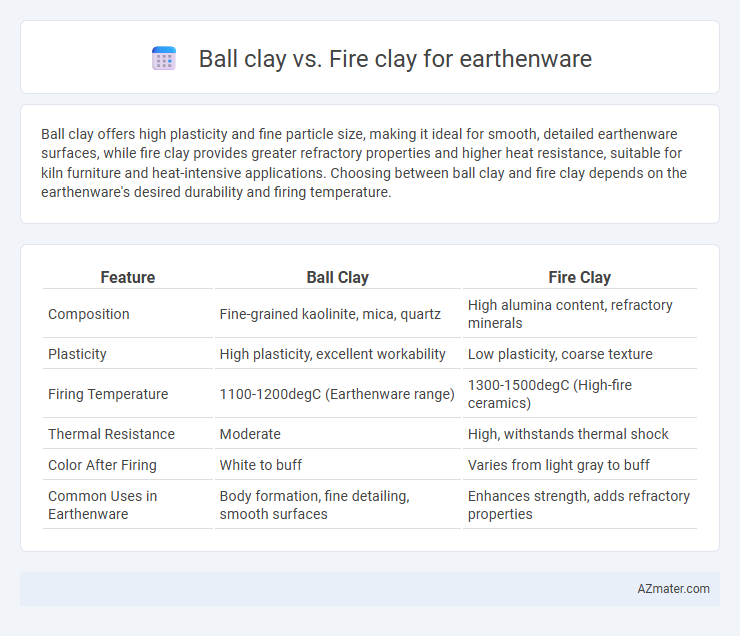Ball clay offers high plasticity and fine particle size, making it ideal for smooth, detailed earthenware surfaces, while fire clay provides greater refractory properties and higher heat resistance, suitable for kiln furniture and heat-intensive applications. Choosing between ball clay and fire clay depends on the earthenware's desired durability and firing temperature.
Table of Comparison
| Feature | Ball Clay | Fire Clay |
|---|---|---|
| Composition | Fine-grained kaolinite, mica, quartz | High alumina content, refractory minerals |
| Plasticity | High plasticity, excellent workability | Low plasticity, coarse texture |
| Firing Temperature | 1100-1200degC (Earthenware range) | 1300-1500degC (High-fire ceramics) |
| Thermal Resistance | Moderate | High, withstands thermal shock |
| Color After Firing | White to buff | Varies from light gray to buff |
| Common Uses in Earthenware | Body formation, fine detailing, smooth surfaces | Enhances strength, adds refractory properties |
Introduction to Ball Clay and Fire Clay
Ball clay is a fine-grained, highly plastic sedimentary clay commonly used in earthenware for its excellent workability and green strength, enhancing the shaping and drying process. Fire clay, characterized by its refractory properties and coarse texture, withstands high firing temperatures, making it essential for heat-resistant earthenware applications. Both clays contribute distinct qualities to earthenware, with ball clay improving plasticity and fire clay providing thermal durability.
Key Differences Between Ball Clay and Fire Clay
Ball clay is finer and more plastic than fire clay, making it ideal for shaping delicate earthenware and providing a smooth surface finish. Fire clay has higher refractory properties and can withstand higher firing temperatures, enhancing durability and thermal resistance in earthenware products. Key differences include ball clay's high plasticity and lower firing temperature, contrasted with fire clay's coarse texture and superior heat resistance.
Mineral Composition: Ball Clay vs Fire Clay
Ball clay contains a high percentage of kaolinite, mica, and quartz, making it highly plastic and ideal for shaping earthenware with smooth surfaces. Fire clay has a higher content of alumina and silica, which provides greater heat resistance and structural strength, essential for fireproof ceramics. The differences in mineral composition affect the workability and firing properties of earthenware clay bodies.
Plasticity and Workability in Earthenware Production
Ball clay exhibits exceptional plasticity and fine particle size, making it highly workable and ideal for shaping intricate earthenware forms. Fire clay, while more refractory and heat-resistant, has lower plasticity and tends to be coarser, resulting in reduced ease of modeling. For earthenware production that demands high plasticity and smooth workability, ball clay is the preferred choice over fire clay.
Firing Temperatures: Ball Clay vs Fire Clay
Ball clay typically fires at lower temperatures, around 1000-1100degC, making it suitable for earthenware that requires a smooth, plastic texture and strong green strength. Fire clay, on the other hand, withstands much higher firing temperatures, often between 1200-1400degC, making it ideal for adding heat resistance and durability to earthenware bodies. The difference in firing temperatures influences the choice depending on whether the goal is ease of shaping or enhanced thermal resistance and strength.
Color and Texture Outcomes in Finished Earthenware
Ball clay typically produces earthenware with a smooth texture and a lighter, creamy color due to its fine particle size and high plasticity. Fire clay results in a coarser texture and a darker, more rustic hue in finished earthenware, thanks to its higher refractory content and impurities. The choice between ball clay and fire clay significantly influences the tactile feel and visual appeal of earthenware pieces.
Applications of Ball Clay in Earthenware
Ball clay in earthenware is prized for its plasticity, fine particle size, and strong bonding properties, making it ideal for shaping detailed and intricate pottery forms. Its high firing strength and low impurities contribute to smooth surfaces and enhanced durability in decorative earthenware products. Compared to fire clay, which is more refractory and used for high-temperature applications, ball clay serves as a key component in achieving workable, fine-textured earthenware bodies.
Uses of Fire Clay in Earthenware Manufacturing
Fire clay is prized in earthenware manufacturing for its high refractory properties, enabling it to withstand elevated firing temperatures without deforming. It is commonly used to produce kiln furniture, refractory linings, and heat-resistant components essential for the firing process. Unlike ball clay, which primarily enhances plasticity and workability, fire clay contributes durability and thermal stability to earthenware products.
Cost and Availability Comparison
Ball clay typically offers a lower cost and higher availability compared to fire clay, making it a preferred choice for earthenware production. Fire clay tends to be more expensive due to its higher refractory properties and limited deposits, resulting in reduced accessibility. Manufacturers select ball clay to optimize economic efficiency while maintaining desirable plasticity and workability for earthenware applications.
Choosing the Right Clay for Your Earthenware Projects
Ball clay offers excellent plasticity and fine particle size, making it ideal for detailed shaping and smooth surfaces in earthenware projects. Fire clay provides high refractory properties and durability, suitable for pieces requiring heat resistance and structural strength. Selecting the right clay depends on whether flexibility and fine texture or thermal resilience and toughness are the primary needs for your earthenware creation.

Infographic: Ball clay vs Fire clay for Earthenware
 azmater.com
azmater.com